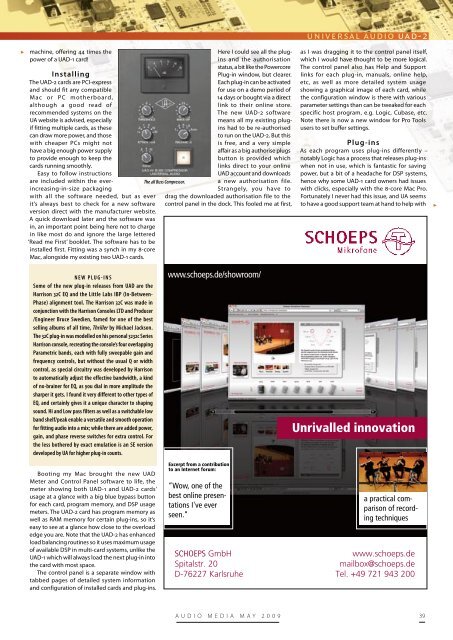Renew Your Audio Media Subscription for 2009!
Renew Your Audio Media Subscription for 2009!
Renew Your Audio Media Subscription for 2009!
Create successful ePaper yourself
Turn your PDF publications into a flip-book with our unique Google optimized e-Paper software.
�<br />
machine, offering 44 times the<br />
power of a UAD-1 card!<br />
Installing<br />
The UAD-2 cards are PCI-express<br />
and should fit any compatible<br />
Mac or PC motherboard,<br />
although a good read of<br />
recommended systems on the<br />
UA website is advised, especially<br />
if fitting multiple cards, as these<br />
can draw more power, and those<br />
with cheaper PCs might not<br />
have a big enough power supply<br />
to provide enough to keep the<br />
cards running smoothly.<br />
Easy to follow instructions<br />
are included within the everincreasing-in-size<br />
packaging<br />
with all the software needed, but as ever<br />
it’s always best to check <strong>for</strong> a new software<br />
version direct with the manufacturer website.<br />
A quick download later and the software was<br />
in, an important point being here not to charge<br />
in like most do and ignore the large lettered<br />
‘Read me First’ booklet. The software has to be<br />
installed first. Fitting was a synch in my 8-core<br />
Mac, alongside my existing two UAD-1 cards.<br />
NEW PLUG-INS<br />
Some of the new plug-in releases from UAD are the<br />
Harrison 32C EQ and the Little Labs IBP (In-Between-<br />
Phase) alignment tool. The Harrison 32C was made in<br />
conjunction with the Harrison Consoles LTD and Producer<br />
/Engineer Bruce Swedien, famed <strong>for</strong> one of the best<br />
selling albums of all time, Thriller by Michael Jackson.<br />
The 32C plug-in was modelled on his personal 3232c Series<br />
Harrison console, recreating the console’s four overlapping<br />
Parametric bands, each with fully sweepable gain and<br />
frequency controls, but without the usual Q or width<br />
control, as special circuitry was developed by Harrison<br />
to automatically adjust the effective bandwidth, a kind<br />
of no-brainer <strong>for</strong> EQ, as you dial in more amplitude the<br />
sharper it gets. I found it very different to other types of<br />
EQ, and certainly gives it a unique character to shaping<br />
sound. Hi and Low pass filters as well as a switchable low<br />
band shelf/peak enable a versatile and smooth operation<br />
<strong>for</strong> fitting audio into a mix; while there are added power,<br />
gain, and phase reverse switches <strong>for</strong> extra control. For<br />
the less bothered by exact emulation is an SE version<br />
developed by UA <strong>for</strong> higher plug-in counts.<br />
Booting my Mac brought the new UAD<br />
Meter and Control Panel software to life, the<br />
meter showing both UAD-1 and UAD-2 cards’<br />
usage at a glance with a big blue bypass button<br />
<strong>for</strong> each card, program memory, and DSP usage<br />
meters. The UAD-2 card has program memory as<br />
well as RAM memory <strong>for</strong> certain plug-ins, so it’s<br />
easy to see at a glance how close to the overload<br />
edge you are. Note that the UAD-2 has enhanced<br />
load balancing routines so it uses maximum usage<br />
of available DSP in multi-card systems, unlike the<br />
UAD-1 which will always load the next plug-in into<br />
the card with most space.<br />
The control panel is a separate window with<br />
tabbed pages of detailed system in<strong>for</strong>mation<br />
and configuration of installed cards and plug-ins.<br />
Here I could see all the plugins<br />
and the authorisation<br />
status, a bit like the Powercore<br />
Plug-in window, but clearer.<br />
Each plug-in can be activated<br />
<strong>for</strong> use on a demo period of<br />
14 days or bought via a direct<br />
link to their online store.<br />
The new UAD-2 software<br />
means all my existing plugins<br />
had to be re-authorised<br />
to run on the UAD-2. But this<br />
is free, and a very simple<br />
affair as a big authorise plugs<br />
button is provided which<br />
links direct to your online<br />
UAD account and downloads<br />
a new authorisation file.<br />
Strangely, you have to<br />
drag the downloaded authorisation file to the<br />
control panel in the dock. This fooled me at first,<br />
The 4K Buss Compressor.<br />
������������������������<br />
���������������������������<br />
���������������������<br />
����������������<br />
�������������������<br />
�����������������<br />
������<br />
SCHOEPS ����<br />
�������������<br />
�����������������<br />
universal audio uad-2<br />
as I was dragging it to the control panel itself,<br />
which I would have thought to be more logical.<br />
The control panel also has Help and Support<br />
links <strong>for</strong> each plug-in, manuals, online help,<br />
etc, as well as more detailed system usage<br />
showing a graphical image of each card, while<br />
the configuration window is there with various<br />
parameter settings than can be tweaked <strong>for</strong> each<br />
specific host program, e.g. Logic, Cubase, etc.<br />
Note there is now a new window <strong>for</strong> Pro Tools<br />
users to set buffer settings.<br />
Plug-ins<br />
As each program uses plug-ins differently –<br />
notably Logic has a process that releases plug-ins<br />
when not in use, which is fantastic <strong>for</strong> saving<br />
power, but a bit of a headache <strong>for</strong> DSP systems,<br />
hence why some UAD-1 card owners had issues<br />
with clicks, especially with the 8-core Mac Pro.<br />
Fortunately I never had this issue, and UA seems<br />
to have a good support team at hand to help with<br />
���������������������<br />
����������������<br />
������������������<br />
��������������<br />
��������������<br />
������������������<br />
��������������������<br />
AUDIO MEDIA MAY <strong>2009</strong> 39<br />
�
















